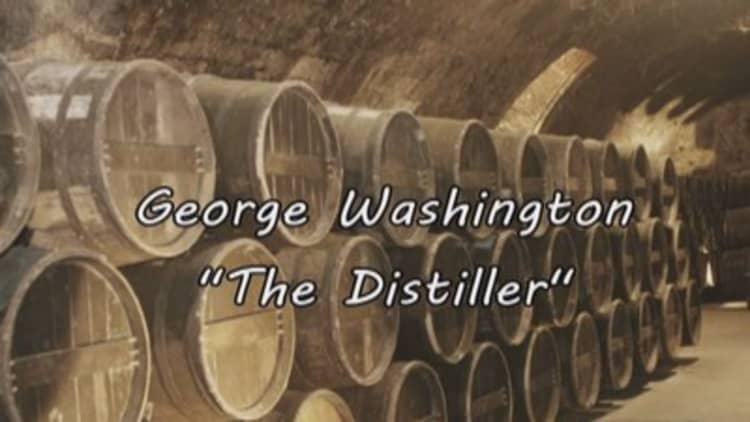
No need to revisit Colonial Williamsburg or the Liberty Bell for your history fix. Getting a literal taste of Americana these days may require just a short trip to the nearest liquor store or bar.
Recreating pre-Prohibition whiskeys, moonshines and other spirits is an idea that has caught on among craft distillers—who are deciphering old family recipes or mash bills, sourcing heirloom grains and hunting down period stills to make it happen. Oh, and putting in a lot of labor to do by hand what might be accomplished by machine in more modern operations.
Craft distilleries have been experiencing a boom, with 420 in production in 2013, up from 32 in 2003, according to the American Distilling Institute.
The growing market prompts distillers to find their own twist to stand out, said Dave Pickerell, managing member at craft spirits advisory firm Oak View Consulting. For some, it's a look back that provides inspiration.
(Read more: No water, no beer! MillerCoors' quest to save water)
"Because of the craft spirit movement principally, I think, there's a renewed interest in finding these old mash bills and replicating them," said Pickerell, who is also a master distiller at George Washington's Mount Vernon, among other distilleries, and a former master distiller for Maker's Mark. "There's a driving force because you can't out-Maker's-Mark Maker's Mark. You have to do something different."
At Asheville Distilling Company in North Carolina, the something different is Crooked Creek, an heirloom white corn that researchers believed extinct since the mid-1800s. Distillery founder Troy Ball uses Crooked Creek discovered at a local farm in her Troy & Sons small-batch moonshine, in a recipe that mixes insights picked up from old-time moonshiners and research from the state archives on period whiskey making. "This corn is actually higher in fats than traditional hybrid corns are," she said. "Of course, that's where the flavor's at, so I love that."
Steve Beam and his brother are recreating the pre-Prohibition whiskey mash bill used by their grandfather—a great-great grandson of Jim Beam founder Jacob Boehm—made by hand and using an heirloom white corn. A mash bill is essentially the recipe for the mash that then gets distilled.
"For me, it's a tie to our heritage," said Beam, an owner of Limestone Branch Distillery in Lebanon, Ky. "To be able to reach back and touch what my grandfather did and his grandfather, it inspires me."
On the deeper end of the trend, there's George Washington's Distillery & Gristmill at Mount Vernon, which has produced spirits including a Maryland-style rye recreated from the first President's recipe and made on-site using period equipment (and typically, by workers wearing period dress). The distillery's first offering in 2010 of 471 bottles sold out within two hours of going on sale. On April 1, it's slated to release 400 bottles of a recreated peach brandy.
(Read more: Skip the tip, restaurant CEO says)
Trendy though it may be, recreating an older spirit is no easy feat. It poses a unique set of challenges for distillers, in large part because Prohibition forced the bulk of small family operations to close.
"Following Prohibition, there wasn't any great race to get back in the business," said Pennfield Jensen, executive director of the American Craft Distilling Association. "They just kind of pulled up their roots and went on." That broke the chain of distilling handed down generation to generation, and resulted in the loss of many earlier mash bills, he said.
Surviving mash bills, if you can find them, aren't always easy to decipher, either. "George Washington's recipe was much easier than most would be, because he was a prolific note-taker," said Pickerell. "Though the recipe itself was never taken down, we have intricate detail of his grain purchases." That documentation, along with other known mash bills in the region, helped distillers determine the right ratios of that grain to recreate Washington's recipe. (Watch the video above for more on Washington's role as distiller.)
Differences over time in strains of grain and fruit available, and equipment used, add to the challenge of a perfect replication. "You can take that recipe that had everything from the exact ratios, weights or amounts of product and put it on a different still, and it's going to have its own fingerprint," said Brian Christensen, editor of Artisan Spirit magazine.
But modern adjustments to pre-Prohibition spirits may actually result in a preferable sip. Traditional moonshiners kept the best part of the distilling run for themselves, selling a blend of the harsher-tasting "head" and "tail" cuts, Ball said. Today's craft distillers sell only that best part. "In many ways, the things we're doing are the things the old men knew, but we're using sophisticated equipment for cleaner whiskey," she said. "Our whiskeys are much smoother than typical whiskeys because we've eliminated all those toxins."
(Read more: Roll out the barrel! Craft beer growth jumps again)
Today's distillers also have more interest in aging spirits. Until the mid-1800s, aging was largely accidental—it happened when you distilled more than you could drink or sell, or the spirit needed to be transported, said Peter Cressy, president and chief executive of the Distilled Spirits Council of the United States. While un-aged spirits and legal moonshines are seeing a renaissance, many distillers are also purposely aging some batches to expand their product lines and experiment.
For imbibers, that may make waiting a necessary element. George Washington's Mount Vernon recently hosted distillers from Scotland to help make a whiskey in the same method as Scotch, using 18th-century techniques. The result is currently awaiting transfer to Madeira casks. And the Beam brothers are focusing on selling moonshine while their whiskey ages, by their estimate, for at least another year or so.
"We'll let the whiskey inside tell us when it's ready," Beam said.
—By CNBC's Kelli B. Grant. Follow her on Twitter @Kelligrant and on Google.


